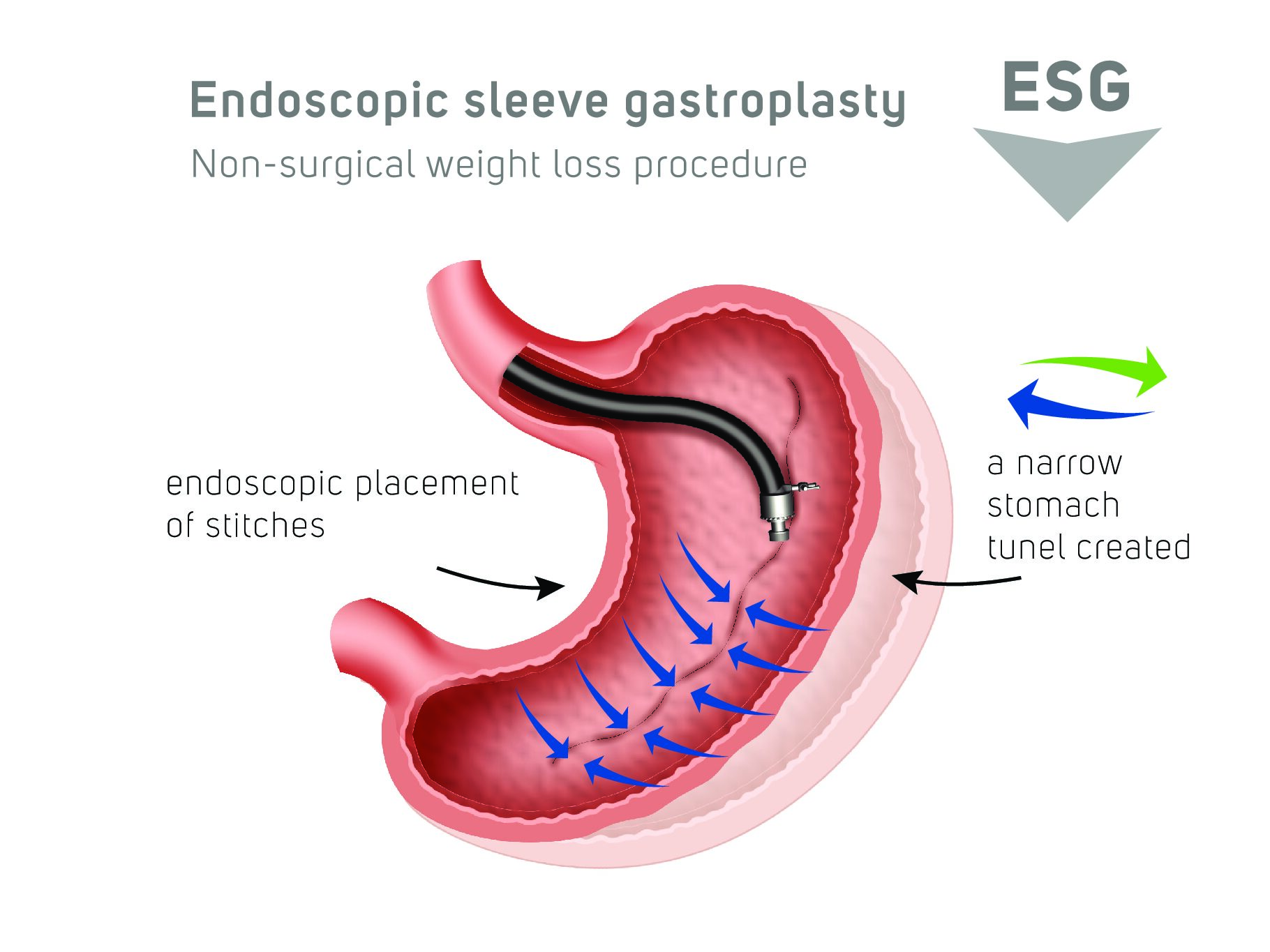Contact the coordinator
+48 75 645 2011
WhatsApp
+48 535 098 999

Contact the coordinator
+48 75 645 2011
WhatsApp
+48 535 098 999
Leave us a message
weightloss@kcmclinic.pl
Endoscopic gastric reduction or suturing, is an innovative, non-surgical, and fully reversible method of obesity treatment, consisting in reducing the volume of the stomach by endoscopic suturing, i.e. sewing the stomach from the inside. This ESG procedure in obese patients can be performed as a primary procedure in people who do not want to undergo bariatric surgery or have contraindications for surgery, or as a revisional bariatric surgery after previous bariatric procedures.
At the KCM Bariatric and Metabolic Surgery Center, after comprehensive diagnostics, this ESG procedure is performed by a very experienced surgeon, well-known in Poland and Europe, a specialist in general surgery, and gastroenterologist, Artur Raiter, MD, PhD
Endoscopic gastric sleeve, so-called endoscopic gastric reduction or endoscopic sleeve gastroplasty is a modern procedure in the treatment of obesity, which complements the offer of surgical treatment of obesity, such as a laparoscopic gastric sleeve or gastric bypass.
Read more For which patients may endoscopic sleeve gastroplasty be recommended? Gastric suturing can already be performed in patients with a BMI of 27, thus not eligible for more invasive obesity treatments such as bariatric surgical procedures. The endoscopic gastric reduction can therefore be performed in patients already with obesity stage I, as a primary procedure. In this case, this ESG procedure can be an alternative treatment to gastric balloons. Endoscopic gastric suturing can also be used as a revisional bariatric surgery, for example, if a patient has undergone obesity surgery years ago, but his stomach stretches again. Endoscopic gastroplasty may be the recommended revisional procedure due to much lower risk than a revisional surgical procedure. Another group of patients who may benefit from endoscopic stomach suturing are patients with a BMI above 60 and can effectively lose weight for the safety of the planned surgical procedure like gastric sleeve or bypass. In this case, endoscopic stomach reduction is performed as the first step of obesity treatment. The planned bariatric surgery can be performed as the second step – after the patient is already much thinner and the risk of surgery and anesthesia is much lower This minimally invasive procedure involves suturing from the inside of the stomach using the video-gastroscope with a small HD camera and Overstitch suturing device, thus reducing the volume of the stomach by 60-80%. A disposable suturing system is inserted into the stomach through the endoscope’s channel to allow sutures to reduce the stomach. During the procedure, which lasts up to about 1 hour, the surgeon, using the appropriate size and type of thread, begins to suture the stomach. After the procedure, the device is removed from the patient’s body. The main advantage of endoscopic stomach stitching is the fact that it is fully reversible. The second main advantage of this treatment is its low invasiveness, without surgical alteration of the anatomical shape of the stomach, without leaving scars or incisions in the stomach wall. Endoscopic gastroplasty in patients who comply with the recommendations shows a little less effective than the more invasive laparoscopic reduction of the stomach, i.e. sleeve gastrectomy (gastric sleeve). The endoscopic gastric suturing procedure is performed under general anesthesia, the hospital stay is very short, the patient goes home the same or the next day after the procedure. Endoscopic gastric sleeve is a relatively safe and much less invasive procedure compared to bariatric surgery. It is a minimally invasive and fully reversible procedure. The sutures/threads placed in order to reduce the capacity of the stomach can be cut out any time endoscopically after the loss of weight, i.e. also non-surgically, and they are excreted with food. Read less


£ 12.700 starting price
Endoscopic sleeve gastroplasty (ESG) cost in the UK

£ 6.690 (All Inclusive)
Endoscopic sleeve gastroplasty (ESG) In Europe with KCM Clinic

KCM Clinic provides the patient with the highest class medical care. Thanks to extensive experience in working with obese patients, the hospital’s team composed an optimal package that contains all the necessary tests and consultations. Before making a final decision about undergoing the procedure, it is useful to learn what comes in the package along with endoscopic sleeve gastroplasty. Cost of the service entails:
Patients that travel from another country and need assistance with organizing their stay in Poland can have it all taken care of by the hospital’s staff. Extra services offered by KCM Clinic include arranging accommodation at Hotel 3* Accor Mercure Jelenia Góra and appointing a personal driver to pick the patient and their companions up from the airport or train station.
Endoscopic sleeve gastroplasty is quite new in comparison to other weight loss procedures. KCM Clinic is one of the few European hospitals that employ highly specialised physicians with many years of experience in conducting this endosurgical treatment. This weight loss procedure takes about 60 to 90 minutes and is carried out under general anaesthesia. This means that the patient is asleep during the endosurgery and does not feel anything.
During the endoscopic sleeve gastroplasty in KCM Clinic, the doctor uses an Apollo OverStitch device. It is a long and flexible tube with a camera and a set of suturing tools at one end. The bariatrician inserts it through the patient’s throat into their stomach. He then sews up the appropriate part of the organ from the inside and removes the endoscope. The OverStitch system is very innovative, and its producer, Apollo Endosurgery, is considered to be a leader in the field of surgical aperture.
Before endoscopic sleeve gastroplasty is it crucially important to properly prepare for the procedure. The process is quite similar to the proceeding prior stomach surgery. The first step of the treatment is a lengthy conversation with a bariatrician and a dietitian. They explain to the patient everything that they need to know and decide if the person qualifies for this treatment. For a few days before the endoscopic sleeve gastroplasty procedure, the patient should remain on a liquid diet not to overburden the stomach. The most important diagnostic test before the procedure is gastroscopy.
Even though endoscopic weight loss treatment is quite safe, there are some contraindications to the procedure. Physicians in KCM Clinic always check if the patient does not suffer from:
This weight loss treatment is also inaccessible to debilitated patients who suffer from cancer. It cannot be implemented if the patient is pregnant, breastfeeding or plans motherhood in the upcoming year.
After waking up from the procedure, the patient is forbidden to eat for eight hours. Then they must follow a liquid diet for at least one week. After that, they usually can start eating soft mousses and purées. During this period, it is crucial for the patient to work closely with a dietitian, whose role is to guide them through the stages of the special diet. The last step is a healthy and balanced meal plan, that should be followed for the remainder of the person’s life. Only in that way can the weight loss achieved through the bariatric treatment be permanent.
Endoscopic sleeve gastroplasty is an effective and safe treatment of obesity. Nonetheless, every patient about to undergo this treatment should strictly adhere to any recommendations given by the doctors and other specialists. These include strictly following a dietary plan before and after the procedure and adhering to instructions regarding physical activity.
During the consultations preceding the treatment, it is very important to be completely honest with the specialists. Their goal is to keep the patient safe and healthy. Every question that they ask is supposed to help them achieve that. All the details about the patient’s previous health history and their attempts at losing weight can be crucial for the doctors. The patient should not omit any information that the specialists ask for.
Many patients that undergo bariatric treatment suffer from diseases other than obesity. Generally, all the necessary medications that the patient has prescribed should be taken at proper intervals, but during the first week after the procedure, all tablets must be crushed and capsules opened. This may change the way they interact with the patient’s body, so it is always mandatory to consult a doctor. He might decide to switch the medication, alter its dose or administer it in a different form.
Following the endoscopic sleeve gastroplasty, the patient is taken to the recovery room, where they wake up from the anaesthesia. Most patients can be discharged from the hospital at the latest on the day after the procedure. They should not drive home or to the hotel alone. The KCM Clinic hospital can arrange the transport for the patient.
Because the endoscopic sleeve gastroplasty is minimally invasive, there are no limitations on physical activity after the procedure. The patient can take care of themselves, go up and downstairs, shower on their own, and even lift household items that are not too heavy. Usually, they do not need another person to assist them, but if possible, it is better to ask somebody to stay nearby. They may also return to work whenever they feel comfortable doing so. There are no contraindications to resuming normal sexual activity.
The exercise routine should be started as quickly as it is possible. It makes for an important element of the weight loss program. The main contraindication for physical activity is the patient’s nausea that often occurs after the reduction of the stomach volume. The vomiting may even cause serious dehydration, so it is important to drink a lot of water. It is beneficial to employ an exercise routine prescribed by a specialist even before the bariatric procedure. It maximizes the chances of the patient’s success in achieving a healthy body mass.
Since the procedure is performed with the use of an endoscope that goes through the patient’s throat without the need to make any incisions in the abdomen, usually there is no need for the patient to stay in the hospital for longer than one day. KCM Clinic offers consultations with multiple specialists that are included in the price of every bariatric procedure. Bariatric patient support group meetings with a dietitian and a psychologist take place every week and are available for patients speaking English, German and Polish.
What distinguishes the endoscopic sleeve gastroplasty from other weight loss procedures is the use of an endoscope that goes through the patient’s oesophagus rather than through an incision in the abdomen. It makes this method significantly less invasive and safer than any bariatric surgery. What is more, during gastroplasty there are no cuts made in the patient’s body and no part of the stomach gets removed.
Laparoscopic sleeve gastrectomy aims at reducing the stomach capacity to the same size as during endoscopic sleeve gastroplasty. The main difference between these two is that in laparoscopic gastrectomy the stretchy part of the organ is cut off and removed, so the operation can never be reversed. During the endoscopic sleeve gastroplasty, the large, elastic part of the stomach is merely sewed up (though the sutures are very resistant and can easily last for the rest of the patient’s life).
After laparoscopic sleeve gastrectomy, it is slightly easier to lose weight than with endoscopic sleeve gastroplasty. The reason for this may be related to a hormone produced by the cells of the stomach, called ghrelin. It causes weight gain by stimulating the appetite. During gastrectomy, the surgeon removes a big portion of the stomach, which significantly lowers the ghrelin level. In the case of gastroplasty, the stomach is sewed up, but its cells still function and produce this hormone. This procedure does not induce any changes in the concentration of ghrelin in the patient’s body.
Any laparoscopic bariatric surgery carries a much greater risk of adverse effects than endoscopic therapy. Unwanted events, such as developing gastro-oesophageal reflux disease, are much more frequent with sleeve gastrectomy than with endoscopic treatment.
How much weight a patient can lose depends largely on adherence to a healthier lifestyle. Those who suffer from obesity-related health problems, such as type 2 diabetes or high blood pressure, and have a body mass index of over 28, should consider consulting an experienced bariatrician. A doctor can help them choose the best weight loss procedure.
KCM Clinic provides the patient with the highest class medical care. Thanks to extensive experience in working with obese patients, the hospital’s team composed an optimal package that contains all the necessary tests and consultations. Before making a final decision about undergoing the procedure, it is useful to learn what comes in the package along with endoscopic sleeve gastroplasty. Cost of the service entails:
Patients that travel from another country and need assistance with organizing their stay in Poland can have it all taken care of by the hospital’s staff. Extra services offered by KCM Clinic include arranging accommodation at Hotel 3* Accor Mercure Jelenia Góra and appointing a personal driver to pick the patient and their companions up from the airport or train station.
Endoscopic sleeve gastroplasty is quite new in comparison to other weight loss procedures. KCM Clinic is one of the few European hospitals that employ highly specialised physicians with many years of experience in conducting this endosurgical treatment. This weight loss procedure takes about 60 to 90 minutes and is carried out under general anaesthesia. This means that the patient is asleep during the endosurgery and does not feel anything.
During the endoscopic sleeve gastroplasty in KCM Clinic, the doctor uses an Apollo OverStitch device. It is a long and flexible tube with a camera and a set of suturing tools at one end. The bariatrician inserts it through the patient’s throat into their stomach. He then sews up the appropriate part of the organ from the inside and removes the endoscope. The OverStitch system is very innovative, and its producer, Apollo Endosurgery, is considered to be a leader in the field of surgical aperture.
Before endoscopic sleeve gastroplasty is it crucially important to properly prepare for the procedure. The process is quite similar to the proceeding prior stomach surgery. The first step of the treatment is a lengthy conversation with a bariatrician and a dietitian. They explain to the patient everything that they need to know and decide if the person qualifies for this treatment. For a few days before the endoscopic sleeve gastroplasty procedure, the patient should remain on a liquid diet not to overburden the stomach. The most important diagnostic test before the procedure is gastroscopy.
Even though endoscopic weight loss treatment is quite safe, there are some contraindications to the procedure. Physicians in KCM Clinic always check if the patient does not suffer from:
This weight loss treatment is also inaccessible to debilitated patients who suffer from cancer. It cannot be implemented if the patient is pregnant, breastfeeding or plans motherhood in the upcoming year.
After waking up from the procedure, the patient is forbidden to eat for eight hours. Then they must follow a liquid diet for at least one week. After that, they usually can start eating soft mousses and purées. During this period, it is crucial for the patient to work closely with a dietitian, whose role is to guide them through the stages of the special diet. The last step is a healthy and balanced meal plan, that should be followed for the remainder of the person’s life. Only in that way can the weight loss achieved through the bariatric treatment be permanent.
Endoscopic sleeve gastroplasty is an effective and safe treatment of obesity. Nonetheless, every patient about to undergo this treatment should strictly adhere to any recommendations given by the doctors and other specialists. These include strictly following a dietary plan before and after the procedure and adhering to instructions regarding physical activity.
During the consultations preceding the treatment, it is very important to be completely honest with the specialists. Their goal is to keep the patient safe and healthy. Every question that they ask is supposed to help them achieve that. All the details about the patient’s previous health history and their attempts at losing weight can be crucial for the doctors. The patient should not omit any information that the specialists ask for.
Many patients that undergo bariatric treatment suffer from diseases other than obesity. Generally, all the necessary medications that the patient has prescribed should be taken at proper intervals, but during the first week after the procedure, all tablets must be crushed and capsules opened. This may change the way they interact with the patient’s body, so it is always mandatory to consult a doctor. He might decide to switch the medication, alter its dose or administer it in a different form.
Following the endoscopic sleeve gastroplasty, the patient is taken to the recovery room, where they wake up from the anaesthesia. Most patients can be discharged from the hospital at the latest on the day after the procedure. They should not drive home or to the hotel alone. The KCM Clinic hospital can arrange the transport for the patient.
Because the endoscopic sleeve gastroplasty is minimally invasive, there are no limitations on physical activity after the procedure. The patient can take care of themselves, go up and downstairs, shower on their own, and even lift household items that are not too heavy. Usually, they do not need another person to assist them, but if possible, it is better to ask somebody to stay nearby. They may also return to work whenever they feel comfortable doing so. There are no contraindications to resuming normal sexual activity.
The exercise routine should be started as quickly as it is possible. It makes for an important element of the weight loss program. The main contraindication for physical activity is the patient’s nausea that often occurs after the reduction of the stomach volume. The vomiting may even cause serious dehydration, so it is important to drink a lot of water. It is beneficial to employ an exercise routine prescribed by a specialist even before the bariatric procedure. It maximizes the chances of the patient’s success in achieving a healthy body mass.
Since the procedure is performed with the use of an endoscope that goes through the patient’s throat without the need to make any incisions in the abdomen, usually there is no need for the patient to stay in the hospital for longer than one day. KCM Clinic offers consultations with multiple specialists that are included in the price of every bariatric procedure. Bariatric patient support group meetings with a dietitian and a psychologist take place every week and are available for patients speaking English, German and Polish.
What distinguishes the endoscopic sleeve gastroplasty from other weight loss procedures is the use of an endoscope that goes through the patient’s oesophagus rather than through an incision in the abdomen. It makes this method significantly less invasive and safer than any bariatric surgery. What is more, during gastroplasty there are no cuts made in the patient’s body and no part of the stomach gets removed.
Laparoscopic sleeve gastrectomy aims at reducing the stomach capacity to the same size as during endoscopic sleeve gastroplasty. The main difference between these two is that in laparoscopic gastrectomy the stretchy part of the organ is cut off and removed, so the operation can never be reversed. During the endoscopic sleeve gastroplasty, the large, elastic part of the stomach is merely sewed up (though the sutures are very resistant and can easily last for the rest of the patient’s life).
After laparoscopic sleeve gastrectomy, it is slightly easier to lose weight than with endoscopic sleeve gastroplasty. The reason for this may be related to a hormone produced by the cells of the stomach, called ghrelin. It causes weight gain by stimulating the appetite. During gastrectomy, the surgeon removes a big portion of the stomach, which significantly lowers the ghrelin level. In the case of gastroplasty, the stomach is sewed up, but its cells still function and produce this hormone. This procedure does not induce any changes in the concentration of ghrelin in the patient’s body.
Any laparoscopic bariatric surgery carries a much greater risk of adverse effects than endoscopic therapy. Unwanted events, such as developing gastro-oesophageal reflux disease, are much more frequent with sleeve gastrectomy than with endoscopic treatment.
How much weight a patient can lose depends largely on adherence to a healthier lifestyle. Those who suffer from obesity-related health problems, such as type 2 diabetes or high blood pressure, and have a body mass index of over 28, should consider consulting an experienced bariatrician. A doctor can help them choose the best weight loss procedure.
My research for where to have bariatric surgery led me to KCM clinic in Poland and I am forever grateful. Everyone was professional and made me feel great. Karolina was so excellent coordinating everything from start, Dr. Grzegorz Kowalski put my mind at ease and did an awesome job.
My procedure was surprisingly extra smooth... Read more
My experience of KCM has been great right from the beginning talking to Kim (My patient co-ordinator) through to surgery day and beyond.
I flew in on a Thursday and had extensive pre op tests Thursday and Friday, then had gastric sleeve surgery on the Saturday and flew home Monday. The whole process ran smoothly and...Read more
Contact the coordinator
+48 75 645 2011
WhatsApp
+48 535 098 999
Leave us a message
weightloss@kcmclinic.pl
NON-INVASIVE TREATMENT OF OBESITY
Send Request
Register
Visits, hospital procedures
Bariatric Surgery Center
Plastic Surgery Center
Spine Surgery Center
Dental Clinic
OMEGA Imaging Diagnostic Center
Work hours
KCM Clinic Wrocław
Chat KCM Clinic
Locations
KCM Clinic Jelenia Góra
KCM Clinic Wrocław
Parking